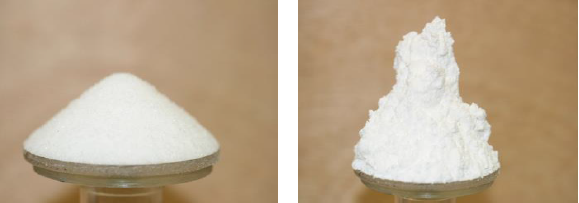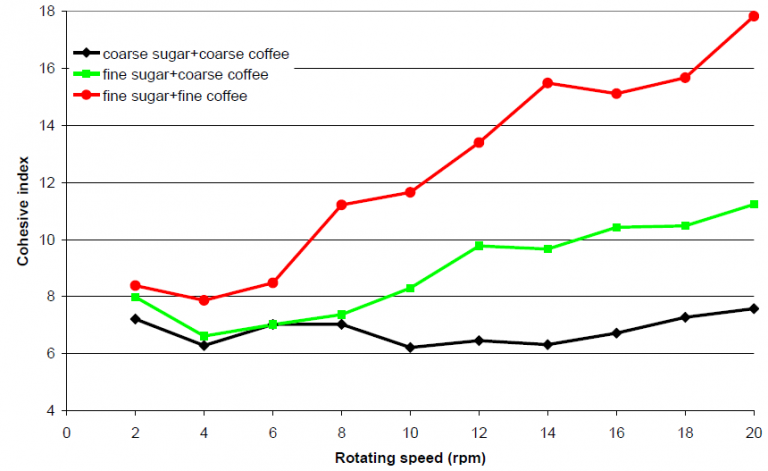Food
Fast methods for powder rheology of sugar blends for R&D and QC using Granudrum and Granuheap
A lot of problems in industrial processes using powders are related to the poor knowledges of the dry powder behavior. Indeed, powder is a complex material with moving properties in time due to external factors as humidity or temperature but also due to a lot of intrinsinc powder properties...
Introduction
A lot of problems in industrial processes using powders are related to the poor knowledges of the dry powder behavior. Indeed, powder is a complex material with moving properties in time due to external factors as humidity or temperature but also due to a lot of intrinsinc powder properties such as particle size and shape, porosity, density, roughness, nature of the material,etc.
Facing all these factors, it is frequently difficult to establish a clear relationship between one or severals of these factors and the problems observed on the production line. However, a lot of these factors have significant effects on the rheological behavior of the powder.
So, measurement of powder flowabilty and cohesion between grains (GranuDrum and GranuHeap) can give good and simple global views of a complex granular system.
From these information strong links can be established between simple macroscopic factors (flowability and cohesion) and behaviors observed on a process line. Powders used or produced in industrial processes are often put in motion in the production line (blender, air convoyering, rotative furnace, mixer, blender, dryer,…). Powder as liquid can be characterized by different behaviors following the stress applying on it or quantity of air trapped between the particles (shear thinning or shear thickening). So, it is important to determine the rheological behavior of the powder in real conditions under motion and to evaluate the evolution of the cohesion in the material under stirring.
Then, you are able to predict and to understand the behavior of the granular material in your process.
This Instrument Allows To:
✓ Classify the samples by using simple concepts based on flowability and cohesion to choose the raw materials, to optimize your process and/or your material;
✓ Quantify the main rheological effects of the powder under motion to evaluate and predict the behavior of your material in your process line;
✓ Control the powder properties to be sure that your process is under control at every time.
The cell of the GranuDrum is a horizontal inox cylinder with glass side walls. The capacity of the cell may vary from 10 to 100 cm3 and is half-filled with the powder sample for analyses. The cylindrical cell rotates around his axis producing the avalanches and the flow of the grains.
LEARN MORE ABOUT THE GRANUDRUM
For each angular velocity, several images of the GranuDrum cell containing the flowed powder are recorded as controlled time-sampling. The position of the air – powder interface is evolved by an edge detection. The average interface position and the fluctuations around this average position are computed.
From the fluctuations of the interface and the interface, respectively cohesion of the grains powder contained inside the cell and dynamic flowability can be obtained. The GranuHeap is based on the formation of a heap of powder on a flat support. Easy to perform and fast (60 seconds), the GranuHeap allows to realize large series of measurements to control a process, to analyze received raw material, to select a new furnisher or even to evaluate a new composition of blends.
LEARN MORE ABOUT THE GRANUHEAP
Fig. 1 shows two heaps of sugar.
While the granular sugar forms a classical conical heap, the powdered sugar forms a strongly irregular heap. Contrary to the granular sugar, the powdered sugar is strongly cohesive, due to the small size of the grains. This example clearly shows that the heap shape strongly depends on the grain properties. In particular, a cohesive granular material gives a high value of the repose angle and strong deviations from the conical shape. Therefore, a precise measurement of the heap shape gives some useful information about interactions between the grains. The angle of repose test is very sensitive to the method used to create the heap.
Therefore, an initialization protocol has been defined in the Granuheap instrument. Moreover, after the heap formation, the measurement of the repose angle is not obvious. The shape of the heap has to be analyzed carefully.
LEARN MORE ABOUT THE GRANUHEAP

Figure 1: Two typical heap shapes. (a) Conical heap shape obtained with a non cohesive granular sugar. (b) Irregular heap of powdered sugar which is a cohesive granular material [1]
Therefore, the classical method which consists in measuring the heap height h on a circular support of diameter ø and in calculating the angle with the relation tan(α)=2h/ ø is subject to caution.
For our measurements, an initialization tube is placed on the support. After filing the tube with the sample of powder, the initialization tube is removed and the powder flows from the tube to form a heap on the support and the handling of the powder by the operator is erased. The support can rotate slowly around its axis. Then, a camera is able to take pictures of the heap for different orientations.
In this way, even if the heap shape is complex and asymmetric (clay, lactose, flour powders with high cohesion), you are able to extract all the geometrical information. From each picture of the heap, a dedicated algorithm finds the position of the interface powder/air by image analysis. The repose angle (αr) is measured by considering the pictures of the heaps of powder. In addition to this parameter, a cohesive index (σr) is measured.
[1] Measuring the flowing properties of powders and grains, Powder Technology, Volume 224, July 2012, Pages 19-27
Applications
Quality control: effect of small particle size on the flowability of a coarse sugar
In industrial process, it is important to determine with the best accuracy the upper and the lower limits in which the process is under control to avoid production of non conform products.
In this example, we consider a blend of two sugars : a coarse (granular) and fine grain size (powdered) sugars. We determine with the GranuHeap instrument the maximum weight percent of powdered sugar (fine particles) to have in the coarse sugar to observe deleterious effects on powder flow-ability.
LEARN MORE ABOUT THE GRANUHEAP
This table shows the main results obtained with the GranuHeap instrument for different blends of sugars.
| Powdered Sugar (wt%) | Repose Angle (°) | Cohesion | Height (mm) | Flow Properties | |
|---|---|---|---|---|---|
| 0 | Average | 41.8 | 0.8 | 14.6 | Passable |
| Std Deviation | 0.7 | 0.0 | 0.4 | ||
| 2 | Average | 41.9 | 0.8 | 14.7 | Passable |
| Std Deviation | 0.6 | 0.0 | 0.5 | ||
| 4 | Average | 42.1 | 0.9 | 14.8 | Passable |
| Std Deviation | 0.6 | 0.1 | 0.5 | ||
| 6 | Average | 45.8 | 1.2 | 16.5 | Poor |
| Std Deviation | 1.1 | 0.2 | 0.2 | ||
| 8 | Average | 49,0 | 1.2 | 18.8 | Poor |
| Std Deviation | 0.5 | 0.3 | 1.0 |
Table: main results obtained with Granuheap instrument
As we can observe in table 2, up to 4 wt % of powdered sugar, the flowability of the blendkeeps constant and it is not affected by the presence of the small particles (powderedsugar) in the blend. Up to 4 wt % of powdered sugar, repose angle is about 41,8° and cohesion index is about 0,8. Above 6 wt%, we can observe that repose angle and cohesion significantly increase (table 2). So, powder behavior is modified by the presence of small particles in the blend.
Above 6 wt% of fine particles, we can conclude without any doubts that powder is characterized by a poor flow property which can have deleterious effect on the process (convoyering, packaging, sensitivity to humidity….). So, 4 wt% of powdered sugar can be considered as the upper limit to avoid any problem on the process line.
LEARN MORE ABOUT THE GRANUHEAP
The GranuHeap instrument can be used as easy and fast control quality test to ensure thatprocess is under control by measuring flow-ability and cohesion of the product throughrepose angle.
R&D- optimization of blend of powders (powdered milk/coffee/sugar)
In order to analyze the compaction dynamics in more details, the curves have been rescaled.
Figure 4 and 5 respectively show the evolution of the Hausner ratio value (d/d0) and the compaction kinetic versus the stress (taps) applied to the powders. The difference observed regarding the initial density for powder without (Powder A) and with fillers (Powder A + Filler) can be explained by the width of the particle size distribution. The small particles brought by the filler can take place in the voids present between the biggest particles increasing by this way the initial density (see table 1 and figure 1).
Subsequently, under the applied stress (taps) and by the voids, small particles can move through the pile given higher Hausner ratios (figure 4) than the sample without filler.
It is also interesting to note that the first taps seem to be the most important ones in the organization and the mechanism of compaction: the compaction kinetic being very fast at the beginning of the measurement. A plateau of relative density is rapidly reached (figure 4 and 5). In our example, it seems that the sample without filler is more sensitive to the first taps than the sample with fillers.
So, less taps are required to reach the plateau of maximum density for the powder without the filler. This behavior is due to the absence of small particles which can percolate through the pile of coarse particles.

Figure 2: cohesion curve vs rotating speed for differents blends tests
As we can observe, cohesion for blend with coarse powders is characterized by a very robust and stable behavior (no variation). Moreover, cohesion index stays very low in all the range of rotating speeds studied. However, replacement of coarse sugar by fine sugar (green curve) leads to an increase of the cohesion of the blend above 8 rpm.
However, up to 8 rpm, the two blends (coarse and fine sugar) are characterized by the same behavior (black and green curves). So, if the stress applied to the blend is weak, powder rheology of the blends can be considered as similar even if fine sugar is used. Replacement of coarse sugar and coffee by fine ones leads to a very significant increase of cohesion according to the stress applied to the blend (red curve). Blend is characterized by a shear thickening behavior above 6 rpm.
Due to the high degree of cohesion under high stress, this powder should be more difficult to convey and to pack. However, this powder is characterized by a low degree of segregation (fig. 3) and this factor has to be keep in mind in blend achievement [2]. Indeed, the use of fine coffee and sugar allows to obtain well dispersed coffee grains in the blend which ensures to the customer a regular taste in its coffee cup. So, blend has to be optimized to meet customer wishes but also technical specifications on the process line.
In conclusion, the GranuDrum instrument can be easily used to optimize and to understand rheological behavior of blend of powders under motion.
LEARN MORE ABOUT THE GRANUDRUM
Moreover, the GranuDrum instrument can be also use to quantify amount of additive to add in a blend of powders to improve its flowability.
 and fine (B) sugar and coffee.png)
Figure 3: respectively coarse (A) and fine (B) sugar and coffee
[2] Cascade of granular flows for characterizing segregation, Powder Technology 234 (2013) 32–36


